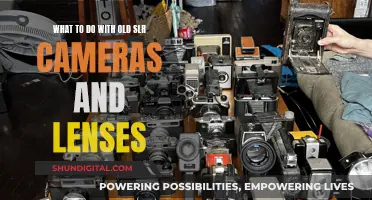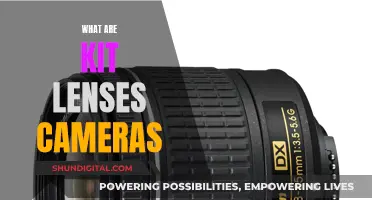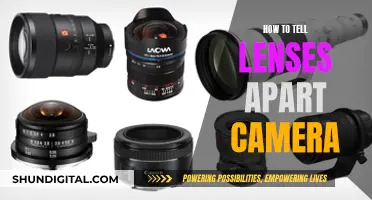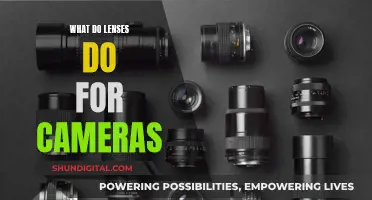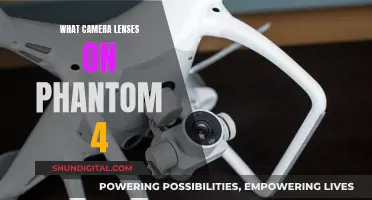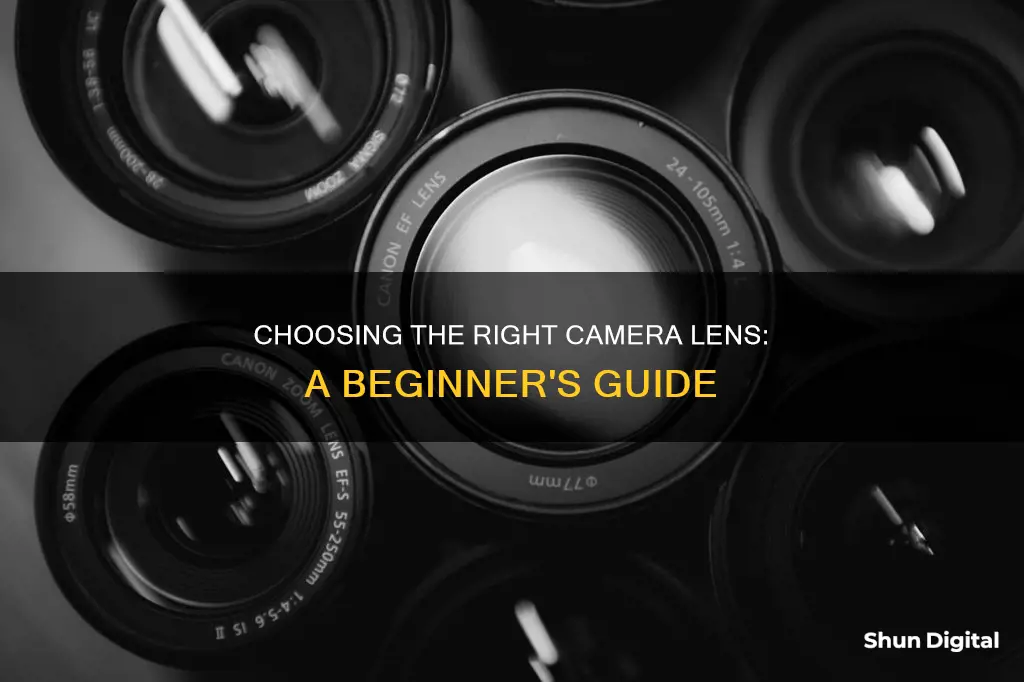
Choosing a camera lens can be a daunting task, especially with the many options available. There are several factors to consider when selecting a lens, including focal length, aperture, zoom vs. prime, compatibility, and budget.
The focal length of a lens determines its angle of view and how zoomed-in it is. For shooting faraway subjects, a lens with a long focal length (above 100mm) is ideal, while a shorter focal length (24-70mm) is better for close-up shots. The aperture refers to how wide the lens opens and affects the amount of light that enters the camera. Wide-aperture lenses (f/2.8 or wider) are better suited for low-light conditions and can create a bokeh effect, while narrow apertures (f/11 and narrower) are ideal for wide-angle shots.
Another decision to make is whether to go for a zoom or prime lens. Zoom lenses offer more versatility as you can adjust the focal length, but prime lenses produce sharper images and typically have wider apertures. Additionally, consider the compatibility of the lens with your camera's sensor size and mount. Check if the lens will physically fit your camera and ensure it is designed for your camera's sensor type (cropped or full-frame).
Finally, your budget will also influence your choice of lens. Name-brand lenses, fast lenses, and zoom lenses tend to be more expensive. Third-party manufacturers like Sigma and Tamron offer more affordable alternatives that are compatible with most top-brand cameras.
The key to choosing the right lens is to consider your specific needs and the type of photography you want to do. By understanding the different lens features and options available, you can make an informed decision that suits your requirements and budget.
| Characteristics | Values |
|---|---|
| Focal length | 8-15mm (ultra wide angle lenses), 16-35mm (wide angle lenses), 35-85mm (standard lenses), 70-150mm (macro lenses), 70-200mm (telephoto lenses), 300mm and up (super telephoto lenses) |
| Aperture | f/2.8 or wider for low light, f/11 and narrower for wide-angle shots |
| Zoom vs. prime | Zoom lenses are more versatile, prime lenses take sharper pictures and have wider apertures |
| Budget | Sigma and Tamron lenses are cheaper than name-brand lenses |
| Compatibility | Check the lens mount matches your camera body, and the lens is compatible with your camera's sensor size |
What You'll Learn

Focal length
The longer the focal length, the narrower the angle of view and the higher the magnification. This is ideal for capturing distant subjects or for situations where you want to get close to the subject without intruding, such as portrait, product, nature, or wildlife photography. Telephoto lenses, with focal lengths ranging from 70mm to 200mm or more, are commonly used for these purposes.
On the other hand, shorter focal lengths result in a wider angle of view and lower magnification. Wide-angle lenses, typically ranging from 8mm to 35mm, are perfect for capturing landscapes, large group photos, architecture, or confined spaces. They allow you to capture a broader view, making them suitable for sweeping landscape shots or environmental portraits.
Standard lenses, with focal lengths between 35mm and 85mm, are often considered to have a "`natural perspective"` similar to the human eye. They offer minimal distortion and are versatile, making them suitable for various photography styles, including portraiture, nature, and low-light situations.
When choosing a lens, it's important to consider the type of photography you'll be doing. Different lenses are better suited for different subjects and styles. Additionally, the camera's sensor size can also impact the effective focal length, with APS-C sensors resulting in a smaller field of view compared to full-frame sensors.
Keeping Camera Lenses: Tips for Longevity and Performance
You may want to see also

Aperture
The size of the aperture is expressed in 'F numbers', for example, F/1.4, F/2.0, F/2.8, F/4.0, etc. The smaller the F number, the larger the aperture, and the greater the amount of light that can pass through. A large aperture (a wide opening) will pass a lot of light, resulting in a brighter photograph. Conversely, a small aperture will make a photo darker.
When choosing a lens, it's important to consider the maximum aperture, as this will determine how much light the lens can gather. Lenses with large apertures are often more expensive. A lens with a maximum aperture of f/1.4 or f/1.8 is considered a "fast" lens, whereas a "slow" maximum aperture of f/4.0 will not be able to capture as much light.
- For portrait photography, a large aperture such as f/1.8 or f/2.8 will create a shallow depth of field, blurring the background and making the subject's face stand out.
- For landscape photography, a small aperture such as f/8 or f/11 is ideal to ensure that both the foreground and background are in focus.
- For low-light photography, a large aperture of f/1.4 or wider will allow more light to enter the lens, resulting in brighter photographs.
- For sports and wildlife photography, a minimum aperture of f/5.6 is recommended to capture sharp images of fast-moving subjects.
Asurion: Cracked Camera Lens Coverage and Claims
You may want to see also

Zoom vs. prime
When it comes to choosing between a zoom and a prime lens, there is no one-size-fits-all answer. The best option for you will depend on your needs, preferences, and shooting style. Here is a detailed comparison to help you decide:
Zoom Lenses:
Zoom lenses offer variable focal lengths, allowing you to adjust your composition without physically moving. They are highly versatile and eliminate the need for frequent lens changes. Zoom lenses are bulkier and heavier due to their complex optical design, and they tend to be more expensive. While zoom lenses are incredibly convenient, they may compromise on image quality, especially in low-light conditions, as they typically have smaller maximum apertures.
Prime Lenses:
Prime lenses have fixed focal lengths, requiring you to move physically to adjust your composition. They are generally smaller, lighter, and more affordable than zoom lenses. Prime lenses offer wider apertures, making them ideal for low-light photography and creating shallow depth of field effects. The fixed focal length of prime lenses can encourage creativity and help you master composition. However, they offer less flexibility, especially in situations where you need to adapt quickly to changing subjects or environments.
When to Choose a Zoom Lens:
- Versatility: Zoom lenses cover a wide range of focal lengths, making them ideal for situations where you need to adapt to different subjects or environments.
- Convenience: With a zoom lens, you can quickly adjust your composition without changing lenses, reducing the risk of missing a shot.
- Travel: When travelling or shooting outdoors, a zoom lens can be more practical as it eliminates the need to carry multiple prime lenses.
- Beginners: If you're just starting, a zoom lens lets you experiment with different focal lengths to find your preferred style without buying multiple lenses.
When to Choose a Prime Lens:
- Image Quality: Prime lenses typically offer superior image quality, with sharper images and better low-light performance due to their wider apertures.
- Creativity: The constraint of a fixed focal length can foster creativity and help you develop a unique shooting style.
- Weight and Size: Prime lenses are lighter and more compact, making them ideal for travel and reducing fatigue during extended shoots.
- Cost: Prime lenses are generally more affordable, especially when considering the price-quality ratio.
Camera Lenses: Almost Perfectly Diffraction Limited?
You may want to see also

Compatibility
Firstly, check that the lens mount matches your camera body. Nikon and Canon camera and lens mounts are not interchangeable, and although you can buy adaptors, it is generally recommended to stay within the same brand. Even within brands, there can be issues with compatibility. For example, Nikon's DSLR lenses will only work on their mirrorless cameras with an adaptor, and Canon lenses present similar issues with DSLR and mirrorless compatibility.
Secondly, you need to consider the sensor size in your camera. Most DSLR and mirrorless cameras are designed with a cropped sensor size, which means you can choose from a wide range of full-frame and cropped-sensor lenses. However, if you have a camera with a full-frame sensor, only full-frame lenses will fit and work properly.
Thirdly, the lens you choose should be compatible with your camera's specifications and body. DSLR and mirrorless cameras are available in two formats: crop sensor and full frame. A full-frame camera will accurately reflect the focal length listed on the lens. However, a crop-sensor camera will have a magnification factor, which means the lens will function at a longer focal length than listed. For example, a 100mm focal length lens used on a Canon crop-sensor camera will function more like a 160mm lens.
Finally, consider the lens quality and coating. Generally, the more expensive the lens, the better the quality. Professional-grade lenses use high-quality glass and lens coatings to increase sharpness, minimise reflections, reduce distortion, and ensure consistency. They also tend to have more durable housing and include weather-sealing for protection in harsh conditions.
What Shape Makes Camera Lenses Work?
You may want to see also

Budget
When it comes to budgeting for a camera lens, there are a few things to keep in mind. Camera lenses can be expensive, but there are ways to save money without sacrificing quality. Here are some tips to help you choose the right lens for your needs and budget:
- Prime vs. Zoom Lenses: Prime lenses have a fixed focal length and are known for delivering high-quality images. They tend to be smaller, lighter, and cheaper than zoom lenses. If you want to travel light or are on a tight budget, a prime lens might be a better option. Zoom lenses offer more flexibility and convenience but can be more expensive and may not deliver the same image quality as prime lenses.
- Aperture: The aperture determines how much light can enter the lens and affects the depth of field. Lenses with wider apertures (lower f-stop numbers) are generally more expensive but are better suited for low-light photography and creating a shallow depth of field. If you're on a budget, consider lenses with smaller apertures (higher f-stop numbers) like f/4 or f/5.6, which are more affordable and suitable for beginners.
- Used Lenses: Buying used lenses can be a great way to save money. However, there are risks involved, such as the lens not working properly or having internal damage. If you decide to buy used, inspect the lens for scratches, dents, mould, loose parts, and ensure the aperture blades are functioning correctly. Buying from a reputable seller with a good return policy can provide some peace of mind.
- Third-Party Lenses: Instead of name-brand lenses, consider third-party options from companies like Rokinon, Sigma, or Tamron. These lenses often provide similar features and quality at a lower price. However, there may be some trade-offs in terms of overall quality or compatibility with specific camera brands.
- Manual Lenses: Manual lenses without autofocus or image stabilisation features are generally cheaper than their automatic counterparts. They require more practice to use but can be a cost-effective option if you're on a tight budget.
- Compatibility: Ensure that the lens you choose is compatible with your camera body and sensor size. Buying a lens that isn't compatible with your camera can be a costly mistake. Check the specifications of your camera and the lens before making a purchase.
- Rent or Buy: If you're unsure about committing to a particular lens, consider renting it first. This can help you try out different lenses within your budget before making a purchase decision.
- Budget-Friendly Options: Some popular budget-friendly lenses include the Canon EF 50mm f/1.8 prime lens and the Nikon 50mm f/1.8G prime lens. These lenses offer excellent value for money and are suitable for various photography types.
Exploring the Diverse World of Camera Lenses
You may want to see also
Frequently asked questions
A zoom lens has a variable focal length, while a prime lens has a fixed focal length. Zoom lenses are more versatile, but prime lenses produce sharper images.
A wide-angle lens has a shorter focal length, capturing a wider image. A telephoto lens has a longer focal length, allowing you to zoom in on distant subjects.
Aperture controls the amount of light entering the camera and determines the depth of field. A wider aperture (lower f-stop number) allows more light in and creates a shallower depth of field, resulting in a stylish blurred background effect.
Firstly, ensure the lens is physically compatible with your camera. Check the sensor size and lens mount compatibility. Then, consider your budget, the type of photography you want to do, and the features you require, such as image stabilisation and autofocus.
Common types of lenses include wide-angle, standard, telephoto, macro, and fisheye lenses. Wide-angle lenses are ideal for landscapes and interiors. Standard lenses are versatile and suitable for everyday use. Telephoto lenses are used for portraits, wildlife, and sports. Macro lenses are designed for extreme close-ups, and fisheye lenses create unique panoramic or circular shots.


